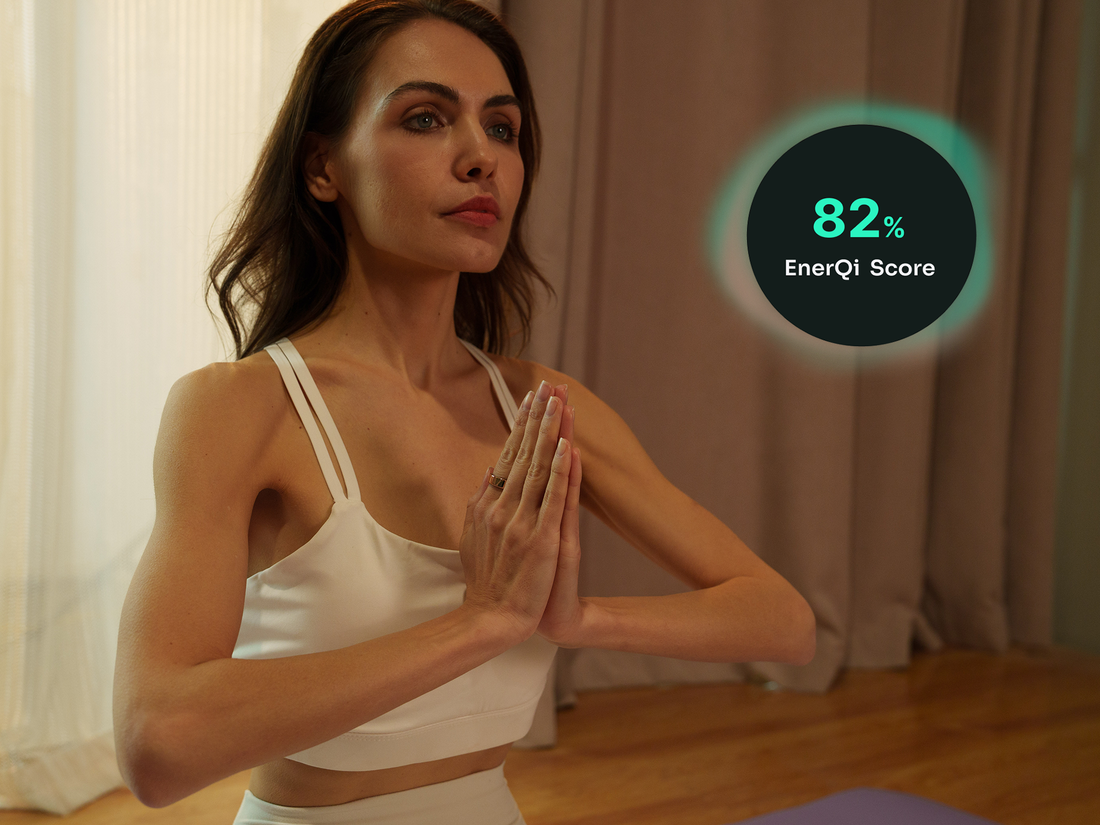
The Secret Language of Your Heart: A Complete Guide to Heart Rate Variability (HRV)
Ever wake up after a full eight hours of sleep but still feel drained and unfocused? Or wonder why some days you can conquer a demanding workload with ease, while on others, even simple tasks feel overwhelming? For many ambitious professionals, managing daily energy can feel like guesswork.
What if you could tune into your body’s own signals to understand your readiness, resilience, and recovery?
Enter Heart Rate Variability (HRV). This powerful metric, tracked by your Omni Health Ring, is one of the best objective measures of how your body is handling physical and mental stress. Understanding your HRV is the first step in moving beyond just tracking your health to strategically improving it. It's a cornerstone of our philosophy: transforming your body's inner rhythm into your strategic advantage in the outside world.
What Exactly is Heart Rate Variability (HRV)?
Most people are familiar with heart rate (HR)—the number of times your heart beats per minute. But HRV is different.
Heart Rate Variability is the measurement of the variation in time between each consecutive heartbeat.
Think of your heart not as a metronome, ticking at a perfectly steady pace, but as a dynamic drummer. When you’re relaxed and your body is in a state of recovery, the drummer is flexible and creative, subtly varying the rhythm between each beat. This high variability is a sign of a healthy, adaptable nervous system. Conversely, when you’re under stress, the drummer becomes rigid and monotonous, with very little variation between beats. This results in a low HRV.
This "drummer" is your Autonomic Nervous System (ANS), the body's control center that operates without your conscious thought. The ANS has two main branches:
1.The Sympathetic Nervous System (The "Fight-or-Flight" System): This is your body's gas pedal. It activates during times of stress, exercise, or excitement, preparing you to face a challenge.
2.The Parasympathetic Nervous System (The "Rest-and-Digest" System): This is your body's brake pedal. It promotes relaxation, digestion, and, most importantly, recovery and repair.
A higher HRV indicates that your parasympathetic system is in control. It shows that your body is resilient and has the resources to recover, adapt, and perform. A lower HRV suggests your sympathetic system is dominant, signaling that your body is under strain from factors like stress, poor sleep, illness, or overtraining.
Why We Track HRV During Sleep
While you can measure HRV at any time, the most accurate and insightful readings are taken during your main sleep. Sleep provides a stable, controlled window where external factors like caffeine, work meetings, or exercise aren't influencing your physiology.
By analyzing your HRV throughout the night, your Omni Health Ring captures a true snapshot of your body's recovery quality. It answers the crucial question: "Is my body truly repairing and recharging from yesterday's demands?" This overnight recovery data forms the bedrock of your daily readiness.
The Power of Your Personal Baseline
There is no universal "good" HRV score. It's a highly personal metric that varies significantly based on age, gender, fitness level, genetics, and lifestyle. A 25-year-old athlete will have a very different HRV profile than a 45-year-old executive.
This is why the concept of a personal baseline is so powerful. Your Omni Health Ring establishes your unique HRV baseline by analyzing your data over time. This dynamic average acts as your personal benchmark. Instead of comparing yourself to others, we compare you to you. This allows us to deliver truly personalized insights, moving "from insight to action."
Decoding the Signals: What Do Changes in Your HRV Mean?
The real magic happens when you track deviations from your personal baseline. These changes are signals from your body, telling a story about your health and resilience. Here’s how to interpret them:
-
HRV on the Rise: An HRV trending above your normal range is a fantastic sign. It indicates your body is well-recovered, resilient, and ready to take on significant challenges. This is a day to tackle a tough workout or a demanding project.
-
A Minor Dip (10-20% below baseline): When your HRV drops moderately, the Omni Health AI may identify this as your "Immune System Under Pressure" or a sign of chronic strain. It’s a yellow light—a call for awareness. This dip could be caused by factors like a looming work deadline, the start of a cold, a late or heavy meal, or a particularly intense training day. It’s your body’s way of saying, "I'm working harder than usual; consider taking it easier."
-
A Significant Drop (Over 20% below baseline): A sharp drop in HRV is a red light, often flagged as a "Body Imbalance." This signals that your body is under significant strain and is diverting major resources to cope. Common culprits include acute illness (like the flu), excessive alcohol consumption, high psychological stress, or severe overtraining. On these days, prioritizing rest and recovery is not just a suggestion—it's essential.
How HRV Shapes Your EnerQi™ Score
At Omni Health, our goal is to go beyond tracking and provide you with actionable strategies to master your energy. This is where your HRV data directly connects to your daily EnerQi™ Score.
The EnerQi™ Score is your real-time energy gauge, answering the question, "How much capacity do I have to perform right now?" The foundation of this score is calculated right after you wake up, based on a comprehensive analysis of your sleep.
Your average HRV during sleep is one of the most critical inputs into this calculation. A high overnight HRV signifies that your "rest-and-digest" system was active, allowing for deep physical and mental restoration. This excellent recovery provides a strong foundation for your energy potential, resulting in a higher starting EnerQi™ Score. Conversely, a low HRV indicates poor recovery, which will be reflected in a lower initial score, alerting you that your body's resources are depleted.
How to Improve Your HRV and Boost Your Resilience
Improving your HRV isn't about quick hacks; it's about building consistent, healthy habits. Here are actionable strategies you can implement:
-
Consistent Sleep: Aim for a regular sleep schedule, even on weekends. Consistent sleep and wake times stabilize your circadian rhythm, which is fundamental to recovery.
-
Mindful Hydration and Nutrition: Stay well-hydrated throughout the day. Avoid large, heavy meals, especially those high in sugar, 2-3 hours before bed. A high-protein, low-glycemic lunch can also help prevent the deep energy slumps that tax your system.
-
Train Smart: Regular exercise can boost your HRV long-term, but overtraining will cause it to plummet. Balance high-intensity workouts with active recovery days. Listen to your body's signals.
-
Manage Stress: You can't eliminate stress, but you can manage your reaction to it. Practices like meditation, deep breathing exercises, or a short walk after a stressful meeting can activate your parasympathetic system and improve HRV.
-
Limit Alcohol: While a glass of wine might feel relaxing, alcohol significantly suppresses HRV and harms your sleep quality. Notice how your HRV responds after a night of drinking.
By understanding the language of your heart, you unlock the power to transform your health. HRV is more than just a number; it's a conversation with your body. It's the key to knowing when to push, when to rest, and how to build a life full of energy and potential.
It’s time to stop guessing and start knowing. It’s time to Own your EnerQi™.
